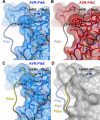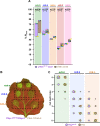The allelic rice immune receptor Pikh confers extended resistance to strains of the blast fungus through a single polymorphism in the effector binding interface
- PMID: 33647072
- PMCID: PMC7951977
- DOI: 10.1371/journal.ppat.1009368
The allelic rice immune receptor Pikh confers extended resistance to strains of the blast fungus through a single polymorphism in the effector binding interface
Abstract
Arms race co-evolution drives rapid adaptive changes in pathogens and in the immune systems of their hosts. Plant intracellular NLR immune receptors detect effectors delivered by pathogens to promote susceptibility, activating an immune response that halts colonization. As a consequence, pathogen effectors evolve to escape immune recognition and are highly variable. In turn, NLR receptors are one of the most diverse protein families in plants, and this variability underpins differential recognition of effector variants. The molecular mechanisms underlying natural variation in effector recognition by NLRs are starting to be elucidated. The rice NLR pair Pik-1/Pik-2 recognizes AVR-Pik effectors from the blast fungus Magnaporthe oryzae, triggering immune responses that limit rice blast infection. Allelic variation in a heavy metal associated (HMA) domain integrated in the receptor Pik-1 confers differential binding to AVR-Pik variants, determining resistance specificity. Previous mechanistic studies uncovered how a Pik allele, Pikm, has extended recognition to effector variants through a specialized HMA/AVR-Pik binding interface. Here, we reveal the mechanistic basis of extended recognition specificity conferred by another Pik allele, Pikh. A single residue in Pikh-HMA increases binding to AVR-Pik variants, leading to an extended effector response in planta. The crystal structure of Pikh-HMA in complex with an AVR-Pik variant confirmed that Pikh and Pikm use a similar molecular mechanism to extend their pathogen recognition profile. This study shows how different NLR receptor alleles functionally converge to extend recognition specificity to pathogen effectors.
Conflict of interest statement
The authors have declared that no competing interests exist.
Figures






Similar articles
-
Multiple variants of the fungal effector AVR-Pik bind the HMA domain of the rice protein OsHIPP19, providing a foundation to engineer plant defense.J Biol Chem. 2021 Jan-Jun;296:100371. doi: 10.1016/j.jbc.2021.100371. Epub 2021 Feb 4. J Biol Chem. 2021. PMID: 33548226 Free PMC article.
-
Cross-reactivity of a rice NLR immune receptor to distinct effectors from the rice blast pathogen Magnaporthe oryzae provides partial disease resistance.J Biol Chem. 2019 Aug 30;294(35):13006-13016. doi: 10.1074/jbc.RA119.007730. Epub 2019 Jul 11. J Biol Chem. 2019. PMID: 31296569 Free PMC article.
-
Effector target-guided engineering of an integrated domain expands the disease resistance profile of a rice NLR immune receptor.Elife. 2023 May 18;12:e81123. doi: 10.7554/eLife.81123. Elife. 2023. PMID: 37199729 Free PMC article.
-
Lessons in Effector and NLR Biology of Plant-Microbe Systems.Mol Plant Microbe Interact. 2018 Jan;31(1):34-45. doi: 10.1094/MPMI-08-17-0196-FI. Epub 2017 Nov 16. Mol Plant Microbe Interact. 2018. PMID: 29144205 Review.
-
Targeting conserved secreted effectors to control rice blast.Trends Plant Sci. 2025 Jan;30(1):7-9. doi: 10.1016/j.tplants.2024.08.001. Epub 2024 Sep 3. Trends Plant Sci. 2025. PMID: 39232945 Review.
Cited by
-
The Molecular Docking of MAX Fungal Effectors with Plant HMA Domain-Binding Proteins.Int J Mol Sci. 2023 Oct 16;24(20):15239. doi: 10.3390/ijms242015239. Int J Mol Sci. 2023. PMID: 37894919 Free PMC article.
-
Resistance that stacks up: engineering rust and mildew disease control in the cereal crops wheat and barley.Plant Biotechnol J. 2023 Oct;21(10):1938-1951. doi: 10.1111/pbi.14106. Epub 2023 Jul 26. Plant Biotechnol J. 2023. PMID: 37494504 Free PMC article. Review.
-
Zinc-finger (ZiF) fold secreted effectors form a functionally diverse family across lineages of the blast fungus Magnaporthe oryzae.PLoS Pathog. 2024 Jun 17;20(6):e1012277. doi: 10.1371/journal.ppat.1012277. eCollection 2024 Jun. PLoS Pathog. 2024. PMID: 38885263 Free PMC article.
-
Disentangling the complex gene interaction networks between rice and the blast fungus identifies a new pathogen effector.PLoS Biol. 2023 Jan 19;21(1):e3001945. doi: 10.1371/journal.pbio.3001945. eCollection 2023 Jan. PLoS Biol. 2023. PMID: 36656825 Free PMC article.
-
Does a Similar 3D Structure Mean a Similar Folding Pathway? The Presence of a C-Terminal α-Helical Extension in the 3D Structure of MAX60 Drastically Changes the Folding Pathway Described for Other MAX-Effectors from Magnaporthe oryzae.Molecules. 2023 Aug 15;28(16):6068. doi: 10.3390/molecules28166068. Molecules. 2023. PMID: 37630320 Free PMC article.
References
Publication types
MeSH terms
Substances
Supplementary concepts
Grants and funding
- BB/M011216/1/BB_/Biotechnology and Biological Sciences Research Council/United Kingdom
- BB/M011216/1/BB_/Biotechnology and Biological Sciences Research Council/United Kingdom
- BB/M02198X/BB_/Biotechnology and Biological Sciences Research Council/United Kingdom
- BB/P012574/BB_/Biotechnology and Biological Sciences Research Council/United Kingdom
LinkOut - more resources
Full Text Sources
Other Literature Sources
Research Materials

